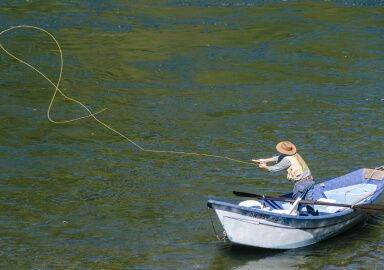Common Ling
Fatter than an eel and longer than a cod, the ling are fierce, bottom-loving predators found around the north-eastern Atlantic Ocean.
View 2 listings
2
listings
–
price starting from
2
countries
–
to the nearest trip
Where and When?
Common ling are distributed mostly along the eastern Atlantic Ocean from northern Norway south to Morocco, including the Mediterranean Sea. They are also found around Greenland, eastern Nova Scotia and some of the Canadian east coast. Smaller ling favour inshore, shallow waters while larger ones are fundamentally deep-water fish with a depth range of about 15-600 m. (50-1 968 ft.).
Mature ling are rarely found close to the shore and favour steep slopes, rocky substrate and any form of hard structure. Off western Europe old shipwrecks, especially those of ships that were blown up and now form scattered structure, are excellent “ling aggregating devices” and are often well known and easy to locate.
Ling may be caught throughout the year with larger fish being mostly caught during the cooler months, but the best fishing months are reported to be from March to July. As the species hunts in deep water the time of day is not important and weather also does not greatly affect them. Tidal movement has a great influence on success, and the best fishing is usually around neap tides.
About Common Ling
The common ling, Molva molva, has been described as looking like a cross between a conger eel and a cod. Fatter than the former and longer and thinner than the latter, ling are fierce ambush predators that dwell on the bottom, mostly in deep waters. Ling are an important commercial trawl and long line species and a popular sport target.
Ling are mottled green, brown, reddish above and paler on the underside. The dorsal and anal fins have a white margin. The species has one large barble at the front of the lower jaw and much larger and sharper teeth than those of cod. They can grow to about 200 cm (79 in.) and 30 kg (66 lbs) during their lives, and can live up to 25 years. The females grow faster than the males and both mature around 5 years old at about 80 cm. (32 in.)
The species feeds aggressively on other fish and occasionally invertebrates and spawns from about March to July annually. A large female is reputed to “carry” between 20 and 60 million eggs, making ling one of the most fecund fish. Ling are basically solitary predators that prefer rocky bottoms, but they are attracted to wrecks and similar structures where they can congregate in large numbers.
How to Catch?
Very few common ling are caught from the shore. The vast majority are landed from land-based private and charter boats. There are many harbours along the Norwegian, Irish, French and Mediterranean coasts that have suitable charters with crews who know the best localities, equipment, baits and methods.
Although the use of artificial lures, such as soft plastics, spoons and jigs is increasing, natural baits are still the most popular fishing method. Fillets and “flappers” of species such as mackerel, herring and pollack are popular, especially if they can be caught fresh on or near the fishing grounds. Drifting over and around wrecks is productive and the bait should be dropped to the bottom, raised slightly and then “worked” gently up and down to attract the ling.
Unfortunately, when elevated from a great depth, the ling undergo barotrauma and their eyes may “pop” and swim bladders extrude from their mouths. This makes catch-and-release problematic, so, once you’ve caught enough ling, it is best to try for other species. To hook and then bring up a decent-sized ling from deep water is quite an experience, but well worth it as they are good fighters and their flesh is highly esteemed.






